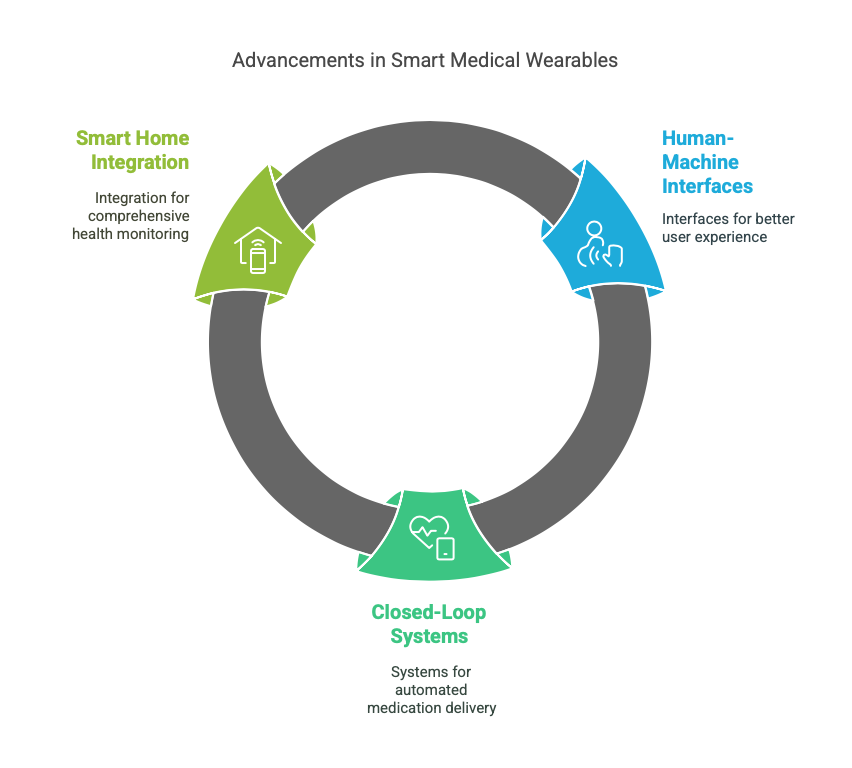The smart medical wearables engineering sector is experiencing unprecedented growth and innovation as we move into 2025. With the global medical wearable devices market projected to reach $196.5 billion by 2030, engineering advances in this field are revolutionizing healthcare delivery and patient monitoring.
Table of Contents
Advanced Biosensor Integration
Smart medical wearables engineering is seeing remarkable progress in biosensor technology. New developments include:
- Multi-parameter biosensors capable of simultaneous monitoring of vital signs, blood glucose, and hormone levels through non-invasive methods. These engineering breakthroughs utilize advanced materials science and miniaturized sensing technologies to provide continuous health data streams.
- Nano-engineered flexible sensors that conform to body contours while maintaining high accuracy. These sensors incorporate graphene-based materials and organic semiconductors, representing a significant advancement in smart medical wearables engineering.
Artificial Intelligence and Machine Learning Integration
The integration of AI/ML capabilities into smart medical wearables represents a major engineering milestone:
- Edge computing implementations allow for real-time data processing and analysis directly on wearable devices, reducing latency and improving response times for critical health monitoring.
- Predictive analytics algorithms can now forecast potential health issues hours or days before physical symptoms manifest, enabling preventive interventions through sophisticated engineering of both hardware and software components.
Extended Battery Life and Power Management
Power efficiency remains a critical focus in smart medical wearables engineering:
- Advanced power management integrated circuits (PMICs) specifically designed for medical wearables extend battery life up to 30% compared to previous generations.
- Energy harvesting technologies, including thermoelectric and kinetic energy systems, are being engineered into devices to supplement battery power and extend operational duration.
Enhanced Data Security and Privacy
Security engineering for smart medical wearables has evolved significantly:
- Hardware-level encryption modules are being integrated into device architecture, ensuring secure data transmission while minimizing power consumption.
- Blockchain integration for medical data management provides immutable records while maintaining HIPAA compliance through innovative engineering solutions.
Miniaturization and Form Factor Innovation
Engineering advances in device miniaturization continue to push boundaries:
- Micro-electromechanical systems (MEMS) technology enables the development of smaller, more efficient sensors without compromising accuracy.
- Flexible printed circuit boards (PCBs) and stretchable electronics allow for more comfortable and less intrusive wearable designs while maintaining full functionality.
Remote Patient Monitoring Capabilities
The engineering of remote monitoring features has become increasingly sophisticated:
- 5G and upcoming 6G integration enables near-real-time data transmission and remote device configuration, supporting advanced telehealth applications.
- Cloud-based monitoring systems with redundant data storage and automated alert systems ensure continuous patient monitoring with minimal latency.
Material Science Advancements
Smart medical wearables engineering has benefited from breakthrough materials:
- Biocompatible polymers and advanced composites reduce skin irritation while improving sensor contact and signal quality.
- Self-healing materials extend device longevity and maintain water resistance, representing significant engineering innovation in durability.
Interoperability and Standards
Engineering efforts are focusing on improved device compatibility:
- Implementation of universal healthcare data standards enables seamless integration with various healthcare systems and electronic health records.
- Open-source protocols facilitate device-to-device communication and data sharing while maintaining security requirements.
Environmental Sustainability
Sustainable engineering practices are becoming central to device development:
- Recyclable and biodegradable components are being engineered into new device designs without compromising performance or reliability.
- Energy-efficient manufacturing processes reduce the carbon footprint of device production while maintaining quality standards.
Future Outlook
The smart medical wearables engineering field continues to evolve rapidly. Key areas for future development include:
- Integration of advanced human-machine interfaces for improved user experience and accessibility.
- Development of closed-loop systems for automated medication delivery based on real-time physiological data.
- Enhanced integration with smart home systems for comprehensive health monitoring environments.

Conclusion
Smart medical wearables engineering is at the forefront of healthcare innovation. As we progress through 2025, these technological advances are making healthcare more accessible, efficient, and personalized than ever before. The convergence of multiple engineering disciplines – from materials science to artificial intelligence – continues to drive innovation in this rapidly evolving field.



 430 Park Ave, New York, NY 10022, USA
430 Park Ave, New York, NY 10022, USA Paevalille tn 6, Office 84, Estonia, Tallinn, 13517
Paevalille tn 6, Office 84, Estonia, Tallinn, 13517 Barykadna St 7, Dnipro, Ukraine, 49000
Barykadna St 7, Dnipro, Ukraine, 49000